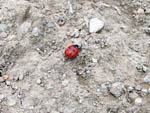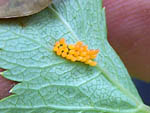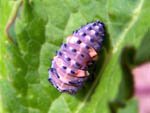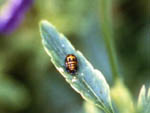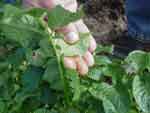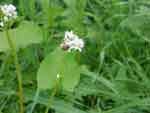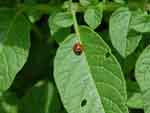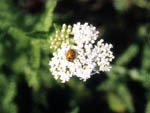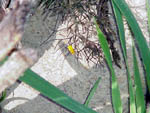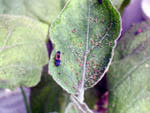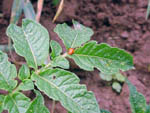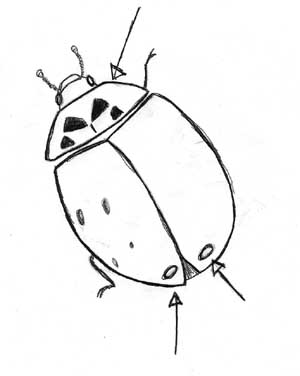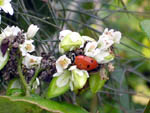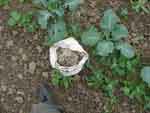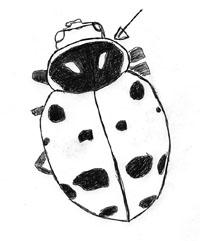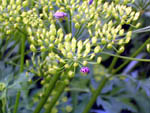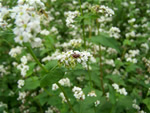Ladybugs |
Parasitic Wasps |
Predatory/Parasitic Flies |
Predatory Bugs |
Lacewings |
Predatory Beetles |
Mantids |
Spiders |
Dragonflies |
Identifying the 4 Most Common Ladybugs
I. How to tell Ladybeetles from Other Insects
Ladybugs are insects that are in the Order Coleoptera (meaning sheath-wing), commonly called beetles. Ladybeetles can vary in color from solid black with 2 red spots to solid orange or red, or they can have variable black spot patterns, sometimes with yellow or red spots. Ladybugs are in the beetle family that entomologists call Coccinellidae. Coccinellid beetles all have the following family characters: the shape of ladybeetles is very distinctive; they have an elongated to oval or hemispherical body; the antennae are eleven-segmented, and they are inserted at the inner margin of the eyes below the front; the antennae have a 3-segmented club on the end; ladybugs can also retract their heads like a turtle into the prothorax; and they have a convex elytra (hard shell wings that cover the inner pair of wings). Almost all beetles in this family are good; however there are 2 pest beetles in this family, the Mexican Bean beetle (Epilachna varivestis Mulsant) and the Squash beetle. They are usually pale yellow and somewhat hairy with 16 or so spots, so watch out!
II. Common Identification Characters of the 4 Most Common Ladybugs
If you have one of these ladybugs, identification can be fairly simple.
1. First, what is the body type of your lady beetle?
The two main body types are oval and round (hemispherical).
A. Round Ladybugs – 2 Types
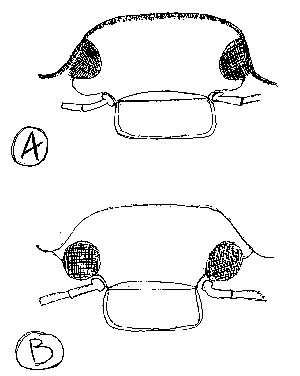 |
Ladybugs can retract their head into their body like a turtle (A).
Normally their head is out as in B. Also, another identifying character
is that the antennae of ladybugs are attached below the front part of
the eyes. |
A. Round Ladybugs – 2 Types
C7
Coccinella septempunctata L. - C7 - The seven-spotted ladybeetle.
| Here's C7 crawling across a field in spring. | C7 ladybeetle eggs on celery. | C7 larva getting ready to pupate; also called a pre-pupa. | C7 pupa on a leaf; don't squish these! |
|
C7 (Coccinella septempunctata L.) or the “Seven-Spotted Ladybeetle”.–We start with the earliest appearing ladybug in the vegetable fields – the C7 ladybug. These ladybugs overwinter in the bark of trees and similar habitats. I am always impressed to see them in relatively barren fields, honing in on the vegetable plants there. Identification: The C7 Ladybug has seven spots on the elytra (hard shelled wings on the back of the beetle); three spots on either side and one joined at the center top near the thorax and head region. Overwinters: C7s overwinter in the bark trees and under leaf litter in some areas. Food plants: C7 ladybugs love any type of mustard plant as well
as other early blooming nectar and pollen sources, like buckwheat, cilantro,
legumes like vetches and red or crimson clover. Also, early aphid sources,
like bronze fennel.
|
|||||
HARMONIA
| Harmonia eggs on bronze fennel. | Harmonia larva - note the flaps or projection that stick off the back of the larva. | Harmonia pupating - do not squash. | Harmonia adult on patrol in potatoes. |
|
The Multicolored Asian Ladybeetle, Harmonia axyridis, congregate in the fall to overwinter. Larvae can be distinguished from other species by the presence of small pads or flaps that project off the back of the larva. Overwinters: After the first hard frost or two, the adults begin to think about getting together to overwinter. In their native lands of China and Japan, the original places they overwintered were on rock outcroppings in the mountains. If your home is light colored and on the side of a mountain, or similar setup, it probably looks just like a big rock outcropping to a ladybug, and this might explain why one October day, the side of your house is covered in ladybugs!! If your neighbor complains about having ladybugs, then collect them for yourself! There are several ways to collect Harmonia. Probably the easiest method is to use a vacuum cleaner (with a new bag), or a long tube sock that you can take out and replace, or a dust buster, and vacuum them up when they start to congregate outside. There are several other methods to collect ladybugs. The Chinese consider it good luck to have these in your house, but if there are too many in your house, see if a nearby gardener or farmer would like to get them for their garden.
|
B. Oval Ladybugs – 2 Types
HIPPODAMIA
Hippodamia convergens - The Convergent Ladybeetle
| Convergent ladybeetle feeding in buckwheat. | Pupae and newly emerged adult of the Convergent Ladybeetle | Convergent ladybeetle larva on nasturtium. | 1 Gallon - 72,000 ladybeetles released in broccoli. |
|
Hippodamia convergens, the “Classic California”
Convergent ladybug, has been shipped nationally for over 100
years, and therefore is naturalized throughout most of the US. It was
originally native to California and the other pacific coastal states.
These are the best overall ladybugs to release against soft-bodied vegetable
pests. The adults are oblong, orange with variable spots. Larvae and
adults actively eat aphids, mites, eggs (pest butterfly/moths eggs,
Colorado Potato Beetle eggs, etc.) of almost any kind, small caterpillars
that they come across (including others of their own kind if they are
hungry).
Food Plants: Wild carrot family (dill, fennel, cilantro, etc.), yarrow & lambsquarters. |
C-MAC
Coleomegilla maculata C-Mac, the Pink & Black Ladybug.
 |
|||
|
Identification: The Pink Spotted Ladybug, Coleomegilla maculata, or also called C-Mac. Distinguishing characters are: less that 1/4” long, oval shape, 6 spots on each forewing of the elytra; and a pink colored elytra with black spots. |
|||
|
C-Mac, Coccinella maculata, are distinctive oblong beetles that are pink and black spotted. Hippodamia ladybugs have a similar body shape but no pink on them. This sets them apart from other ladybugs, although the Hippodamia ladybugs have a similar body shape but no pink on them. C-Macs are the “Porsches” of Ladybugs. They are fast, very active, and are great feeders on eggs of other insects. Therefore, they disperse further and faster than other ladybugs, and they usually cover more territory in a day than other ladybugs. C-Macs have been found to be especially effective against Colorado Potato Beetles, consuming their eggs and small larva. The favored food plants that I find them on are Queen Anne’s Lace and other plants in the wild carrot family. Keep these plants around to keep the ladybugs in your field, garden or yard. Food Plants: The favored food plants that we find them on are
cilantro, parsnips, Queen Anne’s lace and other plants in the wild
carrot family. Keep these plants around to keep the ladybugs in your
field, garden or yard. |
|||
Ladybug Handling and Release:
- The best weather to release ladybugs is cloudy, cool, rainy weather - it makes them seek shelter rather than flying. Put them out nearly colonies of aphids or other food.
- The best time to release ladybugs is just before dark, in the cool of the evening, or even at night. They won’t normally fly at night, and need a “settling down” period after being handled.
- Spray the release area beforehand with water or (I prefer) a 10% sugar solution so they have something to drink. Maintain a high moisture level thereafter.
- Gently shake ladybugs from the container, spreading them around so that they can find food immediately. Release them on or at the base of infested plants.
- Piles of vegetation, stacks of boards or similar materials near dense vegetation are attractive to them as shelter on hot days.
- In greenhouses, screen vents or periodically apply chalk around vents and doors so that ladybugs can’t escape (they can’t cling to vertical chalked surfaces).
- In greenhouses, temperatures between 70° and 85° F are needed for reproduction. Temperatures above 100° F can be tolerated for short periods.
- Ants will “guard” aphids and other soft-bodied honeydew producing insects (like leafhoppers and scales) and protect them from predators like ladybugs. If ants are a problem, you might have to use a sticky product like “Tanglefoot” to make a barrier to prevent the ants from getting to the aphids.
- In order to get your ladybugs to stay as year round greenhouse guests, you should plant Umbellifera as a nectar and mating site for adults.
Keep ladybugs as one of your main pillars of pest defenses in
the your farm and garden. Good luck!
